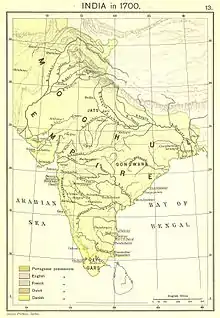Sadaat-e-Bara
Sadat e-Bara sometimes pronounced Sadaat-e-Bahara, are a tribe of Indian Muslim Sayyids, originally Elite or Noble Sayyid families situated in the Muzaffarnagar district of Uttar Pradesh in India.[1] This community had considerable influence during the reign of the Mughal Empire. Its members were also found in Karnal District and Haryana, Gujarat & Karnataka, Maharashtra state in India. Some of the members of this community have migrated to Pakistan after independence and have settled in Karachi, Khairpur State in Sind and Lahore.
 Mohsin-ul-Mulk, a member of the Sadaat-e-Bara | |
| Regions with significant populations | |
|---|---|
| • India • Pakistan | |
| Languages | |
| • Urdu • Hindi • Awadhi | |
| Religion | |
| Islam | |
| Related ethnic groups | |
| • Sayyid • Urdu-speaking people • Arab • Sayyid of Uttar Pradesh• Sadaat Amroha• Gardezi Sadaat • Sadaat-e-Sirsi * Sadaat-e-Bilgram • Sadaat-e-Saithal |
History
Role in the Mughal empire


The Barha Sayyid tribe was famous throughout the country for its obstinate valour and love of fight, as well as religious fervour.[3] The tribe traditionally composed the vanguard of the imperial army, which they alone held the hereditary right to lead in every battle.[4]
Aurangzeb's warning to his sons to be cautious in dealing with the Sayyids of Barha, "...because a strong partner in government soon wants to seize the kingship for himself", would eventually become true.[5][6][7]
Six years after the death of Aurangzeb, the Barhas became kingmakers in the Mughal empire under Qutub-ul-Mulk and Ihtisham-ul-Mulk, creating and deposing Mughal emperors at will.[8]
After the Mughal empire
The Barha Sayyids regained many of their estates from the Marathas and regained their status in the parganah by the time of British arrival.[9]
See also
References
- Markovits, Claude (2002). A History of Modern India, 1480-1950. p. 175. ISBN 9781843310044.
- Journal of Indian HistoryVolume 39. Department of Modern Indian History. 1960. p. 21.
- Mohammad Yasin · (1958). A Social History of Islamic India, 1605-1748.
- Rajasthan Institute of Historical Research (1975). Journal of the Rajasthan Institute of Historical Research: Volume 12. Rajasthan Institute of Historical Research.
- Muhammad Umar (1998). Muslim Society in Northern India During the Eighteenth Century. p. 22. ISBN 9788121508308.
- Jadunath Sarkar (1963). Anecdotes of Aurangzeb. p. 48.
- Sheikh Muhammad (1998). History of Muslim Civilization in India and PakistanA Political and Cultural History. p. 331. ISBN 9789694690018.
- Sen, Sailendra (2013). A Textbook of Medieval Indian History. Primus Books. p. 193. ISBN 978-9-38060-734-4.
- Madan Prasad Bezbaruah, Dr. Krishna Gopal (2003). Fairs and Festivals of India-Volume 3. Indiana University. p. 470. ISBN 9788121208109.